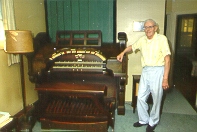
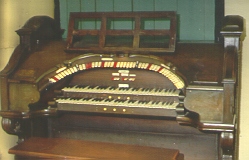
WurliTzer Opus 2027 was installed in the Community Theatre, North Attleboro, Mass. in 1929.
This is a Style 150 with 2 manuals and 5 ranks and percussions.
It is the twin of Opus 2095 which became well
known when it was bought by Ben Hall and installed in his New York apartment in the 60's and became known as the
"Little Mother" WurliTzer.
Specification -
Trumpet 8' - 61 pipes
Tibia Clausa 8'-2' - 85 pipes
Salicional 8'-4' - 73 pipes
Concert Flute 16'-2' - 97 pipes
Vox Humana 8' - 61 pipes
Chimes - 18 notes
Xylophone - 37 notes
Glockenspiel - 37 notes
Bass/Kettle Drum
Snare Drum/Tom Tom
Crash Cymbal
Tap Cymbal
Triangle
Castanets
Tambourine
Sleigh Bells
Bird Whistle
Acme Whistle
Klaxon
Boat Whistle
Surf
Horses Hooves
Fire Gong
Door Bell
It was only used for 2 years before being left in peace until the 1960's when Walter Gelinas rediscovered it and convinced the management to allow him to bring it back to life. In 1968 the theatre manager eventually agreed to sell the instrument to Walter who moved it to his home in nearby Seekonk.

Things then went into slow motion until my regular excursion to the ATOS convention, which was in San Francisco in 1998. After the convention I flew to Chicago with Ryan Heggie, who played at the Young Organists Competition concert during the convention as the 1997 over-all winner of the competition, and his father Ron. We then drove to Seekonk with stops in Detroit, Buffalo, and Rochester to see some of the famous theatre organs in those cities.
Arriving late on Sunday we found Walter waiting for us. Ryan was able to play the instrument one last time for Walter and his wife. Then there was time for a quick tuning and then a brief recording session of the final sounds of the instrument in its second home. During the tuning there were some of the trumpets which were difficult, or impossible, to get right. The cause became clear when it was discovered that several notes had the wrong resonators, some of which were from an Austin rank and even a few complete Austin pipes. This was done to make the pipes fit in the limited height of the basement. Most of the lowest octave had no resonators at all. All the parts were sorted out and accounted for during packing. Then early on Monday July 16 Bob Evans and Don Phipps arrived to help with the removal.
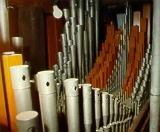 ---Going-
---Going-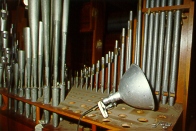 ---Going-
---Going-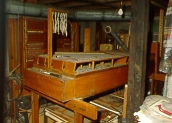
As the pipes and blower etc were removed from the basement and the percussions removed from a bedroom the parts were spread out in the yard ready to be packed into the 20 foot shipping container which had been arranged to be delivered at 10am on that Monday morning. The 3 HP Spencer blower would not fit through the basement door in one piece so it was disassembled, which made it into two heavy main sections (motor and case) instead of one very heavy unit. By Monday afternoon much of the instrument was outside, after much straining, sweating and a few selected words, but there was no container. After numerous phone calls between Seekonk and Seattle (where the shipping was arranged) and Boston (from where the trucking company was to bring the container) the news was that the container would not be arriving until Tuesday morning. Fortunately there was no rain that night.
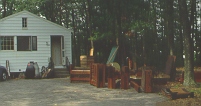 The container arrived about 3pm on Tuesday!
The container arrived about 3pm on Tuesday!
While the parts were spread out the opportunity was taken to get some photos of the parts which are usually less accessible.
By midday Tuesday all the instrument except the console was out. Then the fun part began. The only way out for the console was the same way it entered 30 years before - through the kitchen window, over the kitchen sink, on its back. Two 14 foot planks were positioned from the kitchen floor to the window ledge. The top of the console was tied down to stop it tilting open at any inappropriate time and then it was laid on its back on the planks, with some carpet in between. When the console had been slid up to the window ledge the back ends of the planks were raised to horizontal and supported on two step ladders. The planks, and ladders, were then slid forward under the console so they were protruding from the window, and then the console was pushed forward through the window towards its balance point. The next problem was to get the console down to ground level. All the, full, pipe crates were stacked up and then some concrete blocks were added to reach the required height so that the planks could again be slid under the console to span the gap between the window and the stack so the console could be eased out clear of the window before the blocks were removed to tilt the planks down slightly. After the console was slid down to the stack of crates the planks were slid forward one more time so they reached the ground to allow the console to be brought down to a soft landing on the ground.
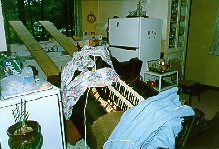 --------
--------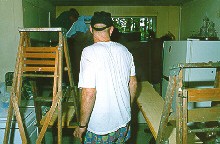 ----------
----------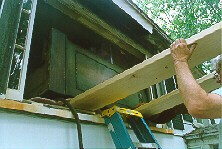
-----Coming--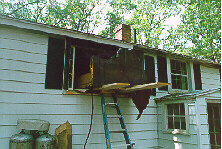 --------
--------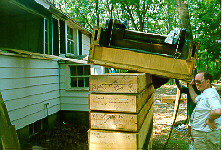 -Down-
-Down-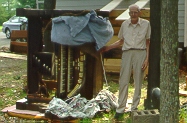
With everything outside it was time to load the container. Unfortunately the container was left on its trailer so everything needed to be lifted up 4 feet again. The shutter frame fitted perfectly across the end of the container and then the pipe crates and main chest were put in, followed by the console down the side. Bourdons, which did not fit into crates and regulators were stacked on the pipe crates to form an even level across most of the end of the container. The Xylophone and Glock fitted into the space and then the floor frames were laid across the top to form a mezzanine level onto which the toy counter, bass drum and trems went. A second, disassembled, set of shutters were stood between the console and the mezzanine and tied in a bundle the side. The relay and switch stack then went in opposite the console and the space in between took the pedal board and assorted pieces of framing. The front corners took the blower and motor, and the Chrys and chime action. Assorted pieces of wind line filled up the spare spaces under the mezzanine, over the Xylo and Glock, and the main wind line from the blower went down the side over the blower and relay with more floor frames forming another platform to support them. There was still enough spare floor space to lay the stage dividing disks out of the blower flat. With about 60 yards of ropes and some blocks screwed to the floor things were made as secure as possible to remain in place during the journey ahead.
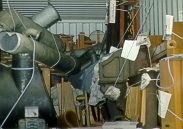
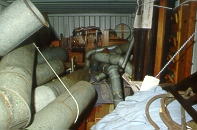
By Thursday morning, after around 150 person-hours of work, everything was ready to go. The truck was due to pick-up at 10am but it was nearly noon when it did arrive. The final action before the doors were sealed was to activate a bug bomb to ensure the many ants, spiders and other bugs that joined us during the packing did not start an invasion, and cause much concern to our quarantine officials. The truck looked like it should have been large enough to get the container to the train which would take it across the country to join the ship in Oakland for the long trip across the Pacific to Adelaide, South Australia.
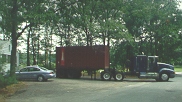
Five very tired and stiff people then resumed their holidays and were grateful this was only a 5 rank instrument. The next exercise will be to unload the container when it eventually arrives. Hopefully Customs will not want to do a detailed inspection of all those boxes and bits before it is released.
The future of Opus 2027...
There are no definite plans at this time. Although it was still fully operational at the time it was removed it still
has all its original 1929 leather. That can not be expected to last too much longer so doing a complete rebuild before
any reinstallation will ensure long and, relatively, trouble free use when it is re-installed. The key, relay and
switch contacts show almost zero wear so there is no need to worry about these or consider replacing them with any form
of modern relay. The console finish has deteriorated badly over the years so a refinishing job will be necessary, along
with some new keyboard felt which became obvious during the recording session when keyboard clatter was sometimes
louder than the pipes. The blower motor will have to be converted to run on our 50 cycle 415v power supply.
This instrument is one of the few smaller theatre organs to have survived intact until now and I intend to ensure it survives in its original form for much longer. The only change that was made to it was to add the Chrys (wired in parallel to the Flute so it could be played at various pitches including 2 2/3!) so the future of that will need to be considered. There is also an extra regulator and trem which may be used to provide separate winding for the Tibia, which was not done originally to save space and cost.
No location for eventual installation has been decided. The last resort will be in my spare bedroom, which is one of the reasons for selecting this size of instrument, but I would much prefer a location in which it will have a more suitable space into which it can speak and it will be seen and heard by as many people as possible. Now there is a real instrument to be offered I hope it will be easier to get interest instead of just trying to "sell" the idea.